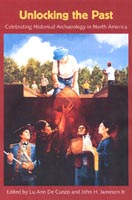"A
Place to Start from": West Oakland, California
Lu
Ann De Cunzo and Mary Praetzellis

Now that you have read about archaeology in Quebec, New York, Alexandria, and Charleston, can you imagine directing the archaeology of forty-three city blocks? Archaeologists at Sonoma State University's Anthropological Studies Center (ASC) got the chance after the great Loma Prieta earthquake of 1989 devastated West Oakland, and their uniquely California story is fascinating. California's Department of Transportation has rebuilt several miles of collapsed and crumbled freeway. Archaeologists are making sure that construction doesn't destroy important remains that have already survived both the original highway construction and the earthquake. It is an immense undertaking mandated by federal law. Where would you start? ASC archaeologists and historians mined the libraries and archives first, gathering maps, photographs, and other hints of the city's land use history. They discovered that some areas remained underwater for much of West Oakland's history, until they received a capping of fill in recent years. Modern construction destroyed early remains in other areas, and land use in yet others left toxic soils unsafe to excavate. In the end, archaeologists determined that fragments of West Oakland's history might still lie buried on twenty-two of the city blocks.
What makes West Oakland's history, and its archaeological and oral history legacy, so important? The answer is transportation. West Oakland is the gateway to the East Bay, the link to San Francisco, and a crucial node in a rail and water transport network extending far beyond California. The economics of transportation defined the city's growth from its beginnings in the 1850s. Oakland began as a peninsula bounded by San Francisco Bay and a broad tidal estuary with a long sandbar silting in its entrance. Since Californians relied entirely on shipping for communication, the timing of landing a vessel became a significant problem. Then in 1862 the Central Pacific Railroad chose Oakland as the terminus for the transcontinental railroad and West Oakland as the locus of its immense shops and yards. Over the next few decades, workers transformed the peninsula environment.
Lu Ann De Cunzo is Associate Professor of Anthropology
at the University of Delaware.
Mary Praetzellis is a historical archaeologist
and the Administrative Manager of the Anthropological Studies Center at
Sonoma State University in California.

